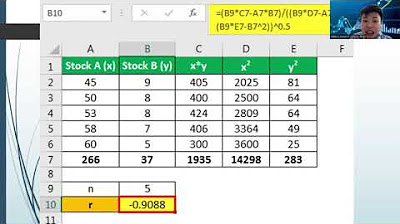PSD - Data Visualization Part.01/02
Summary
TLDRThis lecture introduces data visualization in the context of data science, emphasizing its importance for interpretation and communication. It outlines the basics of visualization, types of data, and visualization techniques. The focus is on data exploration through visualization, which is crucial for identifying trends and patterns. The lecture also touches on the relationship between visualization and statistics, highlighting how visual representation can enhance data interpretation. It categorizes data into nominal, ordinal, interval, and ratio types, and discusses the suitability of different visualizations for each. The session is part of a data science course at the University of Indonesia, supported by academic development funds.
Takeaways
- 📊 The lecture introduces data visualization as a critical component in the field of data science, emphasizing its role in providing clear interpretations of data.
- 🎯 The purpose of the lecture is to explore various forms of data processing, with a focus on the importance of visualizing data for better understanding and analysis.
- 📈 The lecture outlines two types of visualization: exploratory data visualization, aimed at accurately representing what is depicted, and presentation data visualization, aimed at convincing viewers of the accuracy of the representation.
- 🔍 A significant focus in academic and educational settings is on exploratory data visualization, which is crucial for initial analysis before building machine learning systems.
- 📋 The lecture highlights the importance of visualizing data to identify trends, which is more effective than analyzing data in tabular form alone.
- 📊 The necessity of visualization is underscored by its ability to reveal patterns and assist in making predictions, a critical aspect of data analysis.
- 🧠 The lecture connects data visualization with artificial intelligence and machine learning, suggesting that visual insights can inform and improve these technologies.
- 📊 The role of statistics in data visualization is discussed, with an emphasis on using statistical terms like standard deviation and correlation to enhance data interpretation.
- 📚 The lecture categorizes data into four types: nominal, ordinal, interval, and ratio, each with distinct characteristics and visualization requirements.
- 📈 The differences between nominal and ordinal data are clarified, with nominal data lacking order and ordinal data having a ranked sequence.
- 📊 The lecture concludes with a discussion on the types of visualization based on data dimensions, ranging from one-dimensional to three-dimensional, setting the stage for further exploration in subsequent videos.
Q & A
What is the main purpose of data visualization in the context of data science?
-The main purpose of data visualization is to provide a good interpretation of data. When data is visualized effectively, it can be better understood and analyzed.
What are the two types of data visualization discussed in the script?
-The two types of data visualization discussed are 'exploration' and 'presentation'. Exploration focuses on understanding the data, while presentation aims to convince others of the accuracy of the data visualization.
Why is data visualization important before conducting machine learning analysis?
-Data visualization is important before machine learning analysis because it helps to understand the characteristics of the data. It can reveal trends and patterns that are not easily discernible from raw data, which is crucial for building effective machine learning models.
How can visualizing data help in identifying trends?
-Visualizing data can help in identifying trends by representing data in graphical formats such as bar charts, line graphs, or scatter plots. These visual representations make it easier to spot patterns, changes, and correlations within the data.
What is the relationship between data visualization and artificial intelligence or machine learning?
-Data visualization is related to artificial intelligence and machine learning as it provides a way to explore and understand data, which is a fundamental step before applying AI or machine learning techniques. Visual insights can guide the development and tuning of these intelligent systems.
What are the four types of data mentioned in the script?
-The four types of data mentioned are nominal, ordinal, interval, and ratio. These categories help in understanding how data should be visualized and analyzed.
How does nominal data differ from ordinal data?
-Nominal data represents categories without any inherent order, such as gender or types of pets. Ordinal data also represents categories but with a specific order, like ranking or ratings.
What are interval and ratio data types, and how do they differ?
-Interval data types are numeric and have equal intervals between values but no true zero point, such as temperature in Celsius. Ratio data types also have numeric values with equal intervals and a true zero point, indicating a ratio, such as weight or speed.
Why is it important to consider the type of data when creating visualizations?
-Considering the type of data when creating visualizations is important because different data types have different characteristics and require specific types of visualizations to accurately represent the information and insights they contain.
What are the different dimensions of data visualization mentioned in the script?
-The script mentions one-dimensional, two-dimensional, and three-dimensional data visualizations. These dimensions refer to the complexity and depth of the data representation in the visual format.
Who produced the module discussed in the script?
-The module was produced by the Department of Statistics, Faculty of Mathematics and Science, University of Indonesia, with support from the Directorate of Academic Development and Learning Resources (DP ASDP).
Outlines

Cette section est réservée aux utilisateurs payants. Améliorez votre compte pour accéder à cette section.
Améliorer maintenantMindmap

Cette section est réservée aux utilisateurs payants. Améliorez votre compte pour accéder à cette section.
Améliorer maintenantKeywords

Cette section est réservée aux utilisateurs payants. Améliorez votre compte pour accéder à cette section.
Améliorer maintenantHighlights

Cette section est réservée aux utilisateurs payants. Améliorez votre compte pour accéder à cette section.
Améliorer maintenantTranscripts

Cette section est réservée aux utilisateurs payants. Améliorez votre compte pour accéder à cette section.
Améliorer maintenant5.0 / 5 (0 votes)






